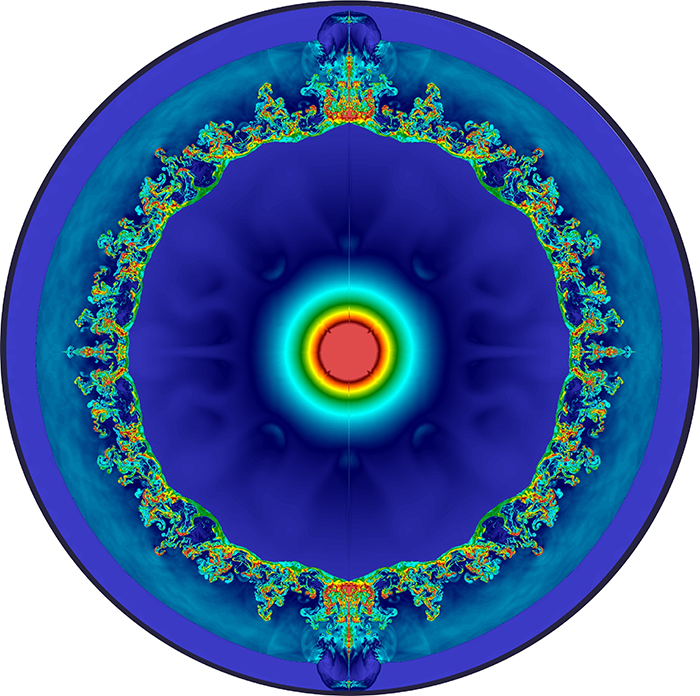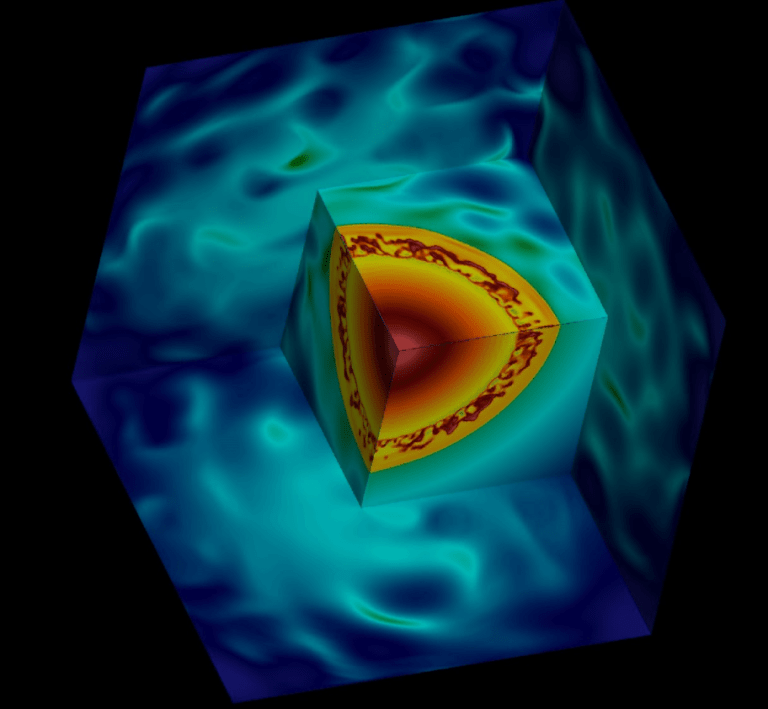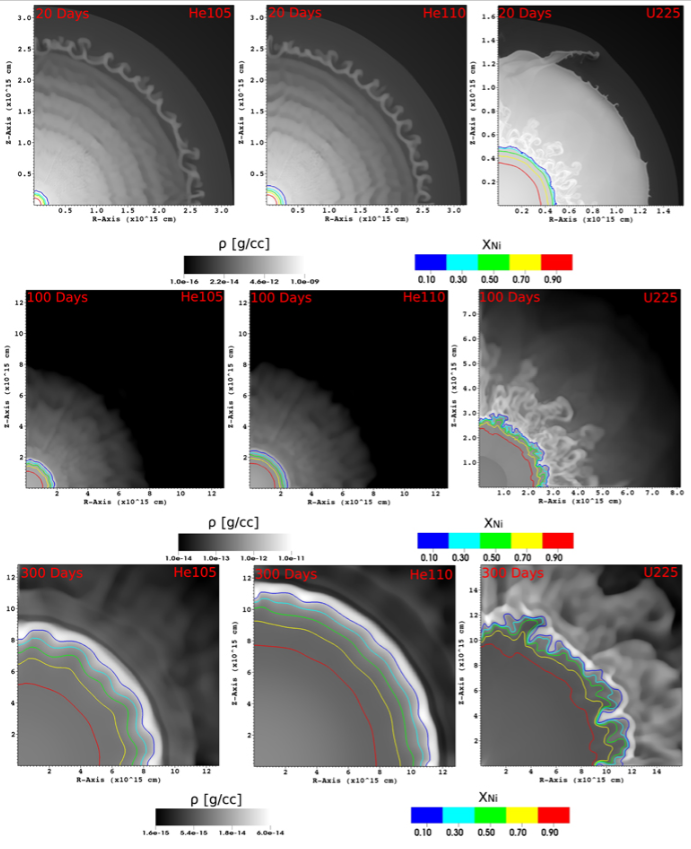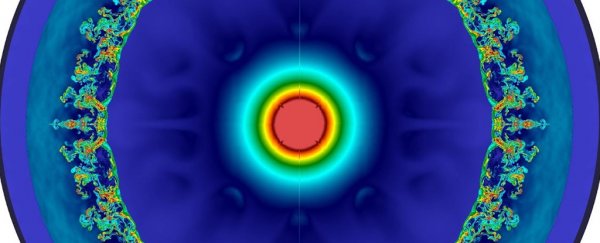The answers to many questions in astronomy are hidden behind the veil of deep time.
One of those questions is around the role that supernovae played in the early Universe. It was the job of early supernovae to forge the heavier elements that were not forged in the Big Bang. How did that process play out? How did those early stellar explosions play out?
A trio of researchers turned to a supercomputer simulation to find some answers.
Their results are presented in a paper titled 'Gas Dynamics of the Nickel-56 Decay Heating in Pair-instability Supernovae'. The lead author is Ke-Jung Chen from the Academia Sinica, Institute of Astronomy & Astrophysics, Taiwan. The paper is published in The Astrophysical Journal.
The work is concerned with a particular type of supernova called a hypernova. They're basically supernovae on steroids. Hypernovae are about 100 times more powerful than garden-variety supernovae, and only occur with stars that are about 130 to 250 solar masses.
Scientists have studied supernovae a lot. Researchers understand how they work, and what types there are. And they know how they forge elements heavier than hydrogen and helium and send those elements out into the Universe when they explode.
But there are important gaps in our understanding, especially in the early Universe.
The trio of researchers wanted to investigate hypernovae, because they think it might give them clues to the very first supernovae that occurred in the Universe, and how the early elements were produced. In the early Universe, stars tended to be more massive, so there may have been more hypernovae.
But hypernovae are extremely rare now, and observing them is problematic. So they turned to supercomputer simulations.
With their simulation, they probed deeply into the core of simulated hypernovae to see what the exploding star looked like 300 days after the explosion began.
 (ASIAA/Ken Chen)
(ASIAA/Ken Chen)
Above: A 2D snapshot of a pair-instability supernova as the explosion waves is about to break through the star's surface.
There are two ways that hypernovae form: from core-collapse, and from pair-instability.
In a core-collapse supernova, a massive star has reached the end of its life and is running out of fuel. As fusion decreases, the outward pressure of fusion declines. Lacking outward pressure, the gravitational energy of the star itself pushes down on the core.
Eventually, the gravitational energy causes the core to collapse, and the star explodes as a supernova. Depending on the star's mass, it can leave behind a neutron star remnant, or a black hole.
A pair-instability supernova happens in extremely massive stars with around 130 to 250 solar masses. It occurs when electrons and their anti-matter counterparts, positrons, are produced in the star.
That creates instability in the star's core, and reduces the internal radiation pressure that's needed to support such a massive star against its own enormous gravity. The instability starts a partial collapse, which triggers a runaway thermonuclear explosion. Eventually, the star is destroyed by a massive explosion, leaving no remnant behind.
For their simulations, the team focused on pair-instability supernovae. One of the reasons for that choice is the large amount of Nickel-56 that pair-instability supernovae can create.
Nickel-56 is a radioactive isotope of nickel and plays an important role in our observations of supernovae. The decay of Ni-56 is what creates the afterglow of a supernova. Without it, a supernova would just be a bright flash, with no lingering light.
The team used the National Astronomical Observatory of Japan's (NAOJ) Center for Computational Astrophysics (CfCA) supercomputer for their simulations.
It's a Cray XC50, and when it started operations in 2018, it was the world's fastest supercomputer for astrophysical simulations. Could all that power help shed some light on the early Universe?
According to lead author Chen, the whole project was extremely challenging.
In a translated press release, Chen said "the larger the simulation scale, to keep the resolution high, the entire calculation will become very difficult and demand much more computational power, not to mention that the physics involved is also complicated."
To combat these, Chen said, their best advantage is their "well-crafted code and a robust program structure." The trio of researchers has experience in long-term simulations of supernovae, so they were well-positioned to do this work.
This is not the first simulation of a hypernova. Other researchers are also keen to understand them, and have done their own simulations. But while previous simulations have run for 30 days after the explosion, this one ran for 300 days.
 (ASIAA/Ken Chen)
(ASIAA/Ken Chen)
Above: A 3D profile of a pair-instability supernovae. The blue cube shows the entire simulated space. Orange region is where nickel 56 decays.
A key reason for this was Nickel-56. As it turns out, Ni-56 does more than create a supernova's long-lived glow. It plays an ongoing role in the explosion. To be thorough, the team ran the simulation for three separate progenitor stars.
A hypernovae needs an extremely massive progenitor star, sometimes upwards of 200 solar masses. That hypernovae can create an enormous amount of Ni-56.
According to the paper, they can synthesize between 0.1–30 solar masses of radioactive Ni-56. And aside from creating all that light, the Ni-56 does other things.
In their paper the authors write that all that Ni-56 "could also drive important dynamical effects deep in the ejecta that are capable of mixing elements and affecting the observational signatures of these events."
The team wanted to probe the "relationship between the gas movement and energy radiation inside the supernova." They found that in the initial stage of Ni-56 decay, the heated gas expanded, and formed structures with thin shells.
Explaining one of the results of the simulation, Chen said, "the temperature inside the gas shell is extremely high, from calculation we understand that there should be ~ 30 percent energy used in gas movement, then the remaining ~ 70 percent energy can likely become the supernova luminosity. Earlier models have ignored the gas dynamic effects, so the supernova luminosity results were all overestimated."
The paper gives more detail. "We find that expansion of the hot 56Ni bubble forms a shell at the base of the silicon layer of the ejecta ~200 days after the explosion but that no hydrodynamical instabilities develop that would mix 56Ni with the 28Si/16O-rich ejecta. However, while the dynamical effects of 56Ni heating may be weak they could affect the observational signatures of some PI SNe by diverting decay energy into internal expansion of the ejecta at the expense of rebrightening at later times."
 (Chen et al, 2020)
(Chen et al, 2020)
Above: A figure from the study. The team simulated three types of hypernovae, represented by the three columns. The rows are snapshots from the simulation at 20, 100, and 300 days. The red line in each image represents the shell of the hot Ni-56 bubble. The simulations showed that the expansion of the Ni-56 bubble doesn't cause any mixing. The mixing in the U225 progenitor star, far right, is due to instabilities from the reverse shock.
This new understanding of pair-instability hypernovae will certainly expand our knowledge of the phenomenon. And it could be an aid to future observations.
Though hypernovae are rare in our age, that may not always have been the case. Since hypernovae require very massive stars, and those stars were more common in the early Universe, it stands to reason that there were more hypernovae in the past.
But soon, we may have instruments capable of seeing the ancient light from some of those hypernovae.
The authors write that "PI SNe
If these future telescopes can observe these early hypernovae, then studies like this one will pave the way for those observations, and provide an avenue for understanding some of what we see.
This article was originally published by Universe Today. Read the original article.
